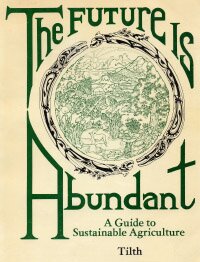
The Future is Abundant
A Guide to Sustainable Agriculture
Tilth Producers of Washington Home | WA Tilth Assoc. | Conference | Directory | Journal | Placement Service | Calendar | Action Alerts
Legislative Update | Bulletin Board | Classifieds | Questions on Agriculture? | Photo Gallery | Links | Contact Us | Join Now | Volunteer

Human assocation with bamboo goes back to the beginning of Asian culture. For 45 centuries, the hardy, rapidly-spreading bamboo has proved ideally suited to stitching together exposed, erosion-prone soils devastated by slash and burn agriculture or clearcutting.
But bamboo's present global omnipresence principally has been due to its usefulness to people. In the face of other resource shortages, cultures of Asia, Africa and Latin America have found bamboo a reliable provider of food, agricultural tools, and materials for manufacture and housing. It is estimated that one-third of humanity makes use of bamboo.
More than 1200 species of bamboo grow around the world, to latitudes 50 degrees north and south of the equator, from sea level to snow line. They range in form from shrubs several inches high to 120' giants more than a foot in diameter. Probably more than 50 bamboo species are adapted to the Pacific Northwest.
All species consist of an underground network of "rhizomes" which absorb, store and transport nutrients and fluids throughout a community of aerial stems, or "culms." In tropical regions "sympodial" types of bamboo have a short, horn-like rhizome, and culms emerge from their tips to form tight clumps.
Temperate, "monopodial" species have long, slender rhizomes. From late summer through fall they extend horizontally through the soil for up to 20 feet. Buds at the joints swell through winter, emerging as shoots in the spring. The culm then elongates rapidly (up to 2 inches per hour) to achieve full height by mid-summer. The culm grows no more, but lives for about a decade, changing its leaves each spring. The rhizome, however, continues to branch and produce new shoots, until the grove flowers. After flowering, the entire grove often dies.
In mountainous regions of China, natural stands of temperate bamboo form a middle story in deciduous and coniferous forests. The shallow rhizome competes little with the deep roots of mature trees. But bamboo is most common in relatively pure stands between forest and farmland, on steep banks of streams and rivers, where the rhizomes bind erosion-prone soil and the culms are convenient for use in adjacent villages and farms.
Most species appreciate warmth, humidity and partial shade. Unprotected south to west slopes should be avoided. Bamboos will grow in a wide variety of soils, but prefer slightly acid, well-drained sandy loam.
Bamboo is generally propagated by rhizome cuttings. Rhizomes radiate from the base of a culm in the top two feet of soil. They are best dug while dormant, in February, cleanly severed and protected from dehydration. They should be young (yellowish in color), with good roots, at least ten good buds, and preferably with several one or two year old culms attached. After planting them to their original depth in a bed of compost mixed with soil, they should be well mulched, and watered regularly.
New shoots are left alone for three years. Then, selective thinning will hasten the development of full-size culms. This process can take five to ten years, as the rhizome grows and is able to support larger shoots and culms.
Many bamboos are rapid spreaders and can become invasive. Proper site selection is important. Bamboo generally spreads downhill. Water, marshes and rock provide natural containment. Continual harvest of shoots or tilling discourages spread. In small plantings, rhizomes can be checked by burying fiberglass, concrete, or galvanized metal sheeting two or more feet deep, extending about a foot above ground.
Bamboo fits well as an agro-forestry crop for small farms. A grove can be quickly established on land unsuited to other economic crops, and provides a high yielding, continual harvest with minimal care.
A bamboo culm matures at four years of age. It is best cut in mid-winter and left standing upright in the grove, with leaves intact, for two weeks. Culms are often submerged in water for about a month to leach out starches, then air-dried under cover for several months.
Shoots of all Phyllostachus species are edible, but "Moso" is the most popular. In Japan and China, Moso is intensively cultivated for shoots on humid, clayey soils, and yields three to ten tons per acre. Raw shoots are toxic, however, and should be boiled at least twenty minutes. They compare to apples in texture, artichoke in taste and onions in nutritive value.
Culms of some species have excellent technical properties, exceeding Douglas-fir in compressive strength while approaching steel in tensile strength. Lightweight, easily harvested and worked, bamboo is useful for stakes, orchard poles, fences, irrigation tubing, flutes, cups, furniture, and virtually every component of shelter.
Easily split when green, bamboo is twisted into rope, woven into baskets, or used as lath for reinforcement in plaster or concrete. It can be bent by subjecting it to heat or steam. When cool, it will retain its shape.
But most of all, bamboo exudes a calm vitality. Seeking enlightenment, Buddha found final shelter, and died, in a bamboo grove.
Tilth Producers of Washington Home | WA Tilth Assoc. | Conference | Directory | Journal | Placement Service | Calendar | Action Alerts
Legislative Update | Bulletin Board | Classifieds | Questions on Agriculture? | Photo Gallery | Links | Contact Us | Join Now | Volunteer